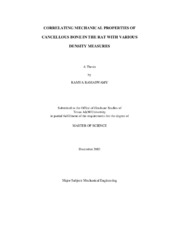| dc.contributor.advisor | Hogan, Harry A. | |
| dc.creator | Ramaswamy, Ramya | |
| dc.date.accessioned | 2004-09-30T01:41:46Z | |
| dc.date.available | 2004-09-30T01:41:46Z | |
| dc.date.created | 2003-12 | |
| dc.date.issued | 2004-09-30 | |
| dc.identifier.uri | https://hdl.handle.net/1969.1/83 | |
| dc.description.abstract | This study focussed on the reduced platen compression (RPC) testing of the cancellous bone of the proximal tibia. The objective of this study was to improve the current testing methods with an emphasis on the location of the RPC specimens, and to correlate the mechanical properties of the rodent cancellous bone with the various density measures. Analytical studies were made to assess the effect of the size and shape of the platen based on the values from mechanical testing of the cancellous bone.
RPC specimens are made from transverse slices of the proximal tibia metaphysis. Specimen location was determined using planar radiograph method at a distance of 1.75 mm distal to the growth plate. The distance from the top of the proximal tibia to the line at 1.75 mm distal to the growth plate was measured and this distance is termed as the first cut distance. Specimen thickness of 2 mm was then cut for the RPC test. Endocortical method was followed to determine the platen sizing for RPC testing. The cancellous bone was then tested in compression to failure.
Correlations were performed between the mechanical properties of the cancellous bone and the density measures from pQCT and radiographic techniques. SigmaStat and TableCurve 2D were used to perform the correlations and estimate the P value for the correlation. Linear and power law fits were made for all the correlations.
Based on this study, several improvements to the reduced platen compression test were recommended. An improved specimen location method was developed. However, it requires a corrective distance to account for the tissue that cannot be identified in the radiographic analysis. A new method for estimating the density of the cancellous bone that is directly tested by the platen was developed. Correlations between the density of the cancellous bone and the mechanical properties show that, there is a strong correlation between ultimate stress and aluminum layer intensity. Elastic modulus correlates best with the last batch tested in this study. Recommendations for future study include advanced technology like finite element analysis and custom shaped platens to enhance RPC testing. | en |
| dc.format.extent | 1781889 bytes | en |
| dc.format.extent | 128557 bytes | en |
| dc.format.medium | electronic | en |
| dc.format.mimetype | application/pdf | |
| dc.format.mimetype | text/plain | |
| dc.language.iso | en_US | |
| dc.publisher | Texas A&M University | |
| dc.subject | Cancellous Bone | en |
| dc.subject | Density | en |
| dc.title | Correlating mechanical properties of cancellous bone in the rat with various density measures | en |
| dc.type | Thesis | en |
| thesis.degree.department | Mechanical Engineering | en |
| thesis.degree.discipline | Mechanical Engineering | en |
| thesis.degree.grantor | Texas A&M University | en |
| thesis.degree.name | Master of Science | en |
| thesis.degree.level | Masters | en |
| dc.contributor.committeeMember | Srinivasa, Arun | |
| dc.contributor.committeeMember | Bloomfield, Susan A. | |
| dc.type.genre | Electronic Thesis | en |
| dc.type.material | text | en |
| dc.format.digitalOrigin | born digital | en |


